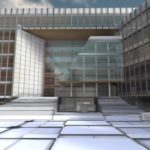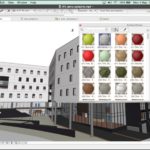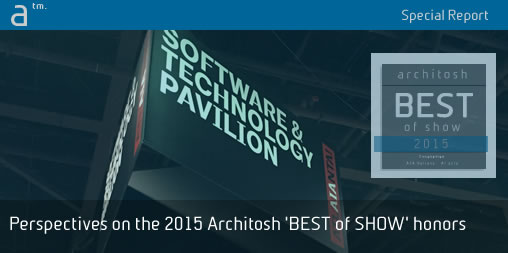Continued from page 1
The Siliconization of Architecture: Through the lens of BEST of SHOW
In the Autodesk Innovation Forum presentation, Phil Bernstein presented around 3 phases for technology change, which in reflecting on the awards and technology this year at the AIA conference support this notion of the siliconization of architecture.
He talked through the first phase “replication”, where technology advances digitize, but repeat existing methods. Then the second phase was labeled “optimization,” which might be characterized as the BIM era. Thirdly, the last phase he described as “disruptive.” The Architosh BEST of SHOW awards span these phases in some very important and notable ways.
INNOVATION Category
The Architosh BEST of SHOW Innovation category provided a strong lens into the disruptive realities of technology’s impact on AECO. CL3VER garnered an Architosh BEST of SHOW with new technology that crossed nearly all of the trends identified above and disruptively in many of the trend areas. It uses HTML5 as a foundation for multiple platforms, devices and wide-open accessibility for extending its use and application. It even achieves “optimization” disruptively by intentionally leveraging the cloud for computation and local GPU horsepower where necessary without requiring a high-end workstation. This product, conceived as a presentation tool, is extremely malleable (we may dare say “clever”) and will be exciting to watch evolve over the next few years. It is by definition disruptive.

03 – The user can literally transform models under UI/UX means for explorative decision-making without the architect literally present.
irisVR also earns an Architosh BEST of SHOW Innovation “Winner” Award by just the right combination of BIM support as a plugin, even with open IFC support. An VR solution that supports the IFC format is a compelling vision that further advances “openness” via the Open BIM philosophy spearheaded by industry giants like Trimble and Nemetschek AG.
With several VR products to review this year, irisVR was the most optimized and disruptive in terms of vision for this technology with a “one click VR” approach for BIM platforms and IFC format. The plugin model is something people understand as it is not unlike the plugin-based export process to specific high-end rendering or analytics packages.
BIM Category
ArchiCAD 19 earned an Architosh BEST of SHOW BIM “Winner” Award for strong optimization in the computational advances which may initially seem subtle, but also really compresses the space between the designer and user of these tools and the work they do in significant ways.

04 – ArchiCAD 19’s new predictive background processing simply utilizes browser tab UI/UX elements and workflow to mask a sophisticated process that solves time.
In a patented technology, the “predictive background processing” manages the rest of the project so that focus on immediate tasks can occur while the rest of the project is maintained and up-to-date in background processes so that when the immediate task is switched, there is no latency–no waiting. This immediate shift is impressive for user experience allowing for uninterrupted thought.
Autodesk Dynamo Studio also received an Architosh BEST of SHOW BIM “Winner” Award in a more disruptive manner by creating a tool that not only pushes integrated computational design toward the early conceptual phases of design, but also does it across disciplines and even platforms outside of silos providing a ubiquitous and open tool for design in many areas of the profession and industry–almost a new design platform extending conventional BIM and method and process. What’s exciting about Dynamo Studio is what’s happening under the hood for an even broader more open computational platform with ability to plugin into “mixed vendor” tool chains.
MOBILE Category
Autodesk continues to be disruptive with FormIt 360 Pro receiving a 2015 Architosh BEST of SHOW MOBILE “Winner” Award by bringing front-end analytics to very early stage design at the field site level. Important collaboration is also achieved through this tool across mobile and desktop again through cloud and browser front end technology. Autodesk FormIt has won BEST of SHOW for mobile three years in a row. We do hope that FormIt 360 Pro will open up to other BIM tools (platforms) much like we also hope that BIMx could utilize IFC models from other tool chains–there were several examples of this open-workflow concept at the conference this year.
PlanGrid was also awarded an Architosh BEST of SHOW MOBILE “Winner” Award as the best field tool digitizing the construction process documents such as an RFI through the whole document lifecycle–and on a single, up-to-date master document available online to the construction team. This unified concept (“single-source of truth”) has emerged directly through the evolution of BIM as a single source for the project model, for the project team and now importantly embraces additional project processes. This product in many ways crossed all phases of replication (digital documentation), optimization (mobiled in the field for construction), and disruption (a living unified AECO document available to the whole team).
DESKTOP Category
Vectorworks Designer 2015 specifically won an Architosh BEST of SHOW DESKOP “Winner” award for its strong upgrade of the Vectorworks Graphics Module (VGM) which recognizes UI graphics and workflow improvements including the first cross-platform BIM program to recognize a 4K display. In the context of the awards this year, this contributes significantly to UI graphics that improve the user experience–no digital artifacts at higher resolutions. This is also reflected in view transitions, geometry and modeling performance improvements—which all keep the users focus on the project rather than the interface or tools.
Other Categories – Runner Ups
Trimble Connect and Autodesk Revit Architecture 2016 also receive Architosh BEST of SHOW BIM “Runner-up” Awards for important reasons as well. Trimble Connect adds a strategic partnership with Nemetschek further decoupling the silo concept around one tool set. It is continuously updated as a web app and very simply available as an extension in Trimble Sketchup. This optimized and open strategy continues to echo in the awards. Autodesk Revit Architecture 2016 creates an output path for hyper-linked views exported to PDF. This digital replication 100% siliconizes the paper process for AECO documentation and output.
While we have discussed in detail here why the Mobile winners were singled out, chief among the concerns with mobile tablet apps is their ability to provide the device a deserving role in the field while simultaneously diminishing the architect’s need to carry rolls of paper documents to every field meeting. These winners, and most past winners, address variously: elimination of redundant paper-based copies, solve single-source of truth (access to that), field-based markup, field-based BIM/3D model viewing, BIM model-to-documentation visual connection, and optimization of standard field processes through digitalization of analog processes.
Finally, a tool we also liked in Atlanta was MassMotion by OASYS. OASYS is the software division at Ove Arup and the division markets its many originally proprietary digital tools for Arup now to the whole market. MassMotion is one of those tools that perhaps only Arup could have made or needed to. Check out the video below. (V3 – video on MassMotion)
MassMotion is the very embodiment of what analytics in architecture can mean to inform the architectural design process based on evidence through research and science. MassMotion brings in 3D models from BIM and CAD programs (or you can model inside the tool) and then allows you to simulate pedestrian flows and behaviors in the built environment. Simply put, it provides evidence through simulation of real outcomes of how well a design will work, and addresses key data-based design challenges architects must all solve like egress and life-safety factors.
If we had different eligibility rules than the ones we have always had, the upcoming Vectorworks 2016 would have likely swept through the BEST of SHOW awards this year. Never before have we seen so many outstanding and sizable new features proposed for a single piece of software. At the future 2016 AIA in Philadelphia, Vectorworks Architect 2016 may stand out as the tool to beat in the BIM category. Introducing not one, or two or even three major BIM spectrum features, version 2016 will include four major new breakthroughs in this fully cross-platform app.
Looking Ahead to 2016
The first of which is Marionette, its combination of visual-scripting parametric modeling technology, the first such happening directly inside a BIM environment. Marionette will beat both Autodesk and McNeel & Associates to market with a true, industrial class visual-scripting parametric modeling environment that goes native on both Mac and Windows. The Python-based Marionette technology will be set loose within the partnership Nemetschek Vectorworks established recently with BIM think tank school Georgia Tech. as well.

05 – Marionette has wired nodes and a python backend direct editing environment, all within Vectorworks 2016.
If that wasn’t enough, Vectorworks 2016 will include an all new workgroup technology enabling multiple people to work on the same files at the same time. This was a vital piece missing in the BIM solution, even with its admittedly very robust federated file system for BIM. It will also include all new integrated Energos energy technology to provide energy analysis from concept through final design, with an emphasis on early stage analytic impact assessment. Finally, the tool will feature very robust point cloud support.
Also not eligible but shown at the show was Vray 3 for SketchUp under development. While many months still off (possibly will ship by year end) the Chaos Group aims to bring all the power of Vray to the world’s most popular modeling tool (it exist now in version 2.x) in an all new two-level UI/UX format—one for rendering newbies that will make configuration a breeze and one for advanced folks which will unlock all the Vray goodness the company offers.
Closing Comments
Paper contract documents, which have defined the professional field of work as “instruments of service” for practice for many decades are beginning to sunset to actual digital processes and methodologies. These methods and processes are beyond drawings in multiple dimensions: for integrated models, costing, sequencing and even operations. These changes are not subtle and change how we value the processes and products of the architectural profession. Even the way we actually interface with the process of design, consultants, fabricators, contractors, and clients within a digital architecture itself.
This year was clear in the convergence of several technologies which realized not only three key principles we have worked around for the Architosh BEST in SHOW awards in the past, but were actualized this year in some unpredicted ways spanning all phases of Bernstein’s technology change. The technologies change the “deliverables,” open the design phase in ways not seen before, and alter through digital collaboration how even the authorship of design is realized. Again, we arrive at what we describe as the siliconization of architecture.
Finally, there were two really big milestones this year creating an interesting intersection of themes through this siliconization of architecture.
Smart documents out of the gate
Autodesk Revit Architecture 2016 seems to complete the 1st phase (replication/duplication) phase in the technology transfer paradigm described by Phil Bernstein. Integrated links to (any) views in Revit saved to PDF with the links intact completes the transformation from paper documents to intelligent electronic documents. There is more advanced work being completed by many software and hardware companies, but this lifts the boat to an ubiquitous platform that gives no quarter to paper. It is now a digital practice. BIMx also can do this through their Hyper-model technology and several of the awards this year in all the categories contribute to this siliconization of architecture. This, combined with the work of CMD/Vimtrek with the AIA could deeply impact the professional practice of architecture, including as a business segment, in a very meaningful way.
VR as a disruptive technology is happening now
The Oculus Rift is a VR technology that is consumer driven and at a cost that is similar or even less than some typical computer hardware (like a computer monitor). Architecture is a spatial act in material and immaterial ways. Oculus Rift and competing technologies, such as the Microsoft Hololens (Augmented Reality (AR)), present familiar space but space that is constructed by design–both informationally, perceptually technically and importantly experientially.
This even specifically matters to Apple as they acquired augmented reality company Metaio as part of their AR strategy. This is an addition to Apple’s recently revealed VR patents.
As an interface to design and evaluate design through, VR and AR are happening now, contributing to the siliconization of architecture, and broadly impacting real architectural practice sooner than many in the industry will be comfortable with. For more reading read
LINK TO ARCHITOSH VR AT 2015 CONVENTION
Post Script
Liquid and Transarchitecture conceived by Marcos Novak in the mid 90’s reframing architectural practice was described as, “the necessity for architects to reorient, at least partially, the conceptual base of their practicing architecture–specifically, to accept computer programming as a collaborative architectural act and come to terms with virtual space and virtual production as they have with physical 2D and 3D space.” (1)
(1) Dollens, Dennis “D2A: Digital to Analog Architecture,” 2002





Reader Comments
#CAD AIA: Perspectives on BEST of SHOW 2015—IT Trends in Architectural Practice http://t.co/zeX8KNbbYy
http://t.co/MBWu09g2YT — senior assoc. editor, Pete Evans, AIA, looks at the cutting edge IT trends in Architecture! http://t.co/S37WcBJP49
#CAD AIA: Perspectives on BEST of SHOW 2015—IT Trends in Architectural Practice http://t.co/zeX8KNbbYy
http://t.co/MBWu09g2YT — senior assoc. editor, Pete Evans, AIA, looks at the cutting edge IT trends in Architecture! http://t.co/S37WcBJP49
RT @architosh: http://t.co/MBWu09g2YT — senior assoc. editor, Pete Evans, AIA, looks at the cutting edge IT trends in Architecture! http:/…
RT @architosh: http://t.co/MBWu09g2YT — senior assoc. editor, Pete Evans, AIA, looks at the cutting edge IT trends in Architecture! http:/…
Comments are closed.